Blues Dance
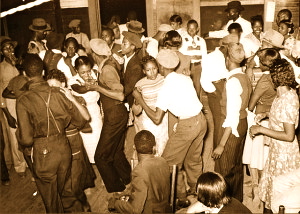
The Spirit Moves Blues Dance Historical
Blues Dancing Part 3 Speakeasy Blues Dancing. Blues dancing original footage from 1930’s from dvd “the spirit moves.
 Young African Americans dancing in a juke joint in Mississippi.
Young African Americans dancing in a juke joint in Mississippi.
Blues dancing is a family of historical dances that developed alongside and were danced to blues music, or the contemporary dances that are danced in that aesthetic. Amateur Dancer carried an article entitled “Blues and Rhythm and Blues Dancing” in a July/August 1991 issue.
Mura Dehn used the term “The Blues” in The Spirit Moves, Part 1, as the sub-section title of Chapter II, referencing different dance styles.
African-American essayist and novelist Albert Murray used the term “blues-idiom dance” and “blues-idiom dance movement” in his book Stomping the Blues.
History of Blues Dancing
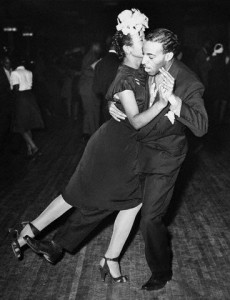 Early commentators on dance from sub-Saharan Africa consistently commented on the absence of close couple dancing, and such dancing was thought to be immoral in many traditional African societies. In all the vast riches of sub-Saharan African dance heritage there seems to be no evidence for sustained one-on-one male-female partnering anywhere before the late colonial era, when it was apparently considered in distinctly poor taste.
Early commentators on dance from sub-Saharan Africa consistently commented on the absence of close couple dancing, and such dancing was thought to be immoral in many traditional African societies. In all the vast riches of sub-Saharan African dance heritage there seems to be no evidence for sustained one-on-one male-female partnering anywhere before the late colonial era, when it was apparently considered in distinctly poor taste.
In the United States the dances of white Americans were being adapted and transformed over time. As dance evolved, the Afro-American elements became more formal and diluted, the British-European elements more fluid and rhythmic.
Dance moves passed down through generations were revised, recombined, and given new flourishes. The cyclical re-emergence of similar elements marks the African-American dance vocabulary.”
During the post Reconstruction period (1875–1900), as Jim Crow Laws were passed in the South, dance steps once linked to ritualistic or religious dancing also acquired a more secular identity. Where by and large slavery had inhibited the retention of specific African tribal culture, the dances of working-class and lower-class blacks relinquished some of their Euro-American characteristics in during this time. Meanwhile, “dances became more upright and less flat-footed. As dance became more associated with sexuality and the free consumption of pleasure, which in the jook still had some communal ties to group dancing, the partnering relationship became more isolated and individualized. The “sport” and the “good-time gal” were people of the moment. Hip shaking and pelvic innuendo were now more of a statement to one’s partner than to one’s community.”
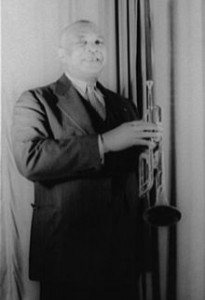 W. C. Handy in July 1941, by Carl Van Vechten
W. C. Handy in July 1941, by Carl Van Vechten
W. C. Handy, who wrote some of the first published blues songs, documented his earliest experience with what may have been blues, and dancers reaction to it, at a dance c. 1905 in Cleveland, Mississippi. At one point Handy was asked to “play some of our native music”. Although “baffled” he had his band played “an old-time Southern melody”, after which he was asked if a local band could play a few numbers. That group consisted of “just three pieces, a battered guitar, a mandolin and a worn-out bass” (Handy described the group as “a Mississippi string band”) and played “one of those over-and-over again strains that seem to have no very clear beginning and certainly no ending at all…. It was not really annoying or unpleasant. Perhaps “haunting” is a better word for it…The dancers went wild.”
Handy also described the reaction to his band, which included violin, guitar, string bass, clarinet, tenor saxophone, trombone, and trumpet, playing his song “Mr. Crump” in 1909. “We were all settled into our chairs. I flashed the sign and the boys gave. Feet commenced to pat. A moment later there was dancing on the sideways below. Hands went in the air, bodies swayed like reeds on the banks of the Congo….In the office buildings about, white folks pricked up their ears. Stenographers danced with their bosses. Everybody shouted for more.”
While playing mostly one-steps, polkas, schottishes and waltzes for colored patrons at Dixie Park in Memphis, Handy noted a reaction to the habanera rhythm included in Will H. Tyler’s “Maori”. “I observed that there was a sudden, proud and graceful reaction to the rhythm….White dancers, as I had observed them, took the number in stride. I began to suspect that there was something Negroid in that beat.” After noting a similar reaction to the same beat in “La Paloma”, Handy included this rhythm in his St. Louis Blues, the instrumental copy of Memphis Blues, the chorus of Beale Street Blues, and other compositions.”
Handy also elicited an enthusiastic reaction from colored dancers at the old K. of P. Hall with “a sort of Italian climax with a tricky rhythm” at the end of the first four bars of his “Memphis Blues”. “During the playing I noticed periodic shouting from the floor, and a great roar of voices broke out when we came to a certain point in the piece. “Set in it”, I heard them say. “Set in it!”. Others told me of hearing happy little squeals among the Negro dancers for whom they played the piece.”
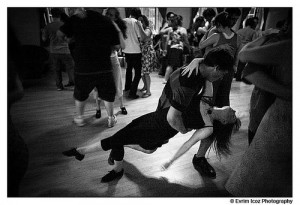 Writing about the first time “St Louis Blues” was played (1914), Handy notes that “The one-step and other dances had been done to the tempo of Memphis Blues…. When St Louis Blues was written the tango was in vogue. I tricked the dancers by arranging a tango introduction, breaking abruptly into a low-down blues. My eyes swept the floor anxiously, then suddenly I saw lightning strike. The dancers seemed electrified. Something within them came suddenly to life. An instinct that wanted so much to live, to fling its arms to spread joy, took them by the heels.”
Writing about the first time “St Louis Blues” was played (1914), Handy notes that “The one-step and other dances had been done to the tempo of Memphis Blues…. When St Louis Blues was written the tango was in vogue. I tricked the dancers by arranging a tango introduction, breaking abruptly into a low-down blues. My eyes swept the floor anxiously, then suddenly I saw lightning strike. The dancers seemed electrified. Something within them came suddenly to life. An instinct that wanted so much to live, to fling its arms to spread joy, took them by the heels.”
The great Delta blues player Johnny Shines, who was born in 1915, recalled that “mostly you played for the dancers… They were doing two-steps and quite a few waltzes in those days.”
“So far as what was called blues, that didn’t come till ’round 1917…What we had in my coming up days was music for dancing, and it was of all different sorts” – Mance Lipscomb, Texas guitarist and singer.
A tune called “Slow Drag Blues”, composed by Snowden, was recorded c. 1915-19 by Dabney’s Band.
Black dancers in Chicago continued to use the term “slow dragging” through the 1940s. By the 1960s, however, the term “belly-rubbing” gained acceptance. In the 1970s, both blacks and whites referred to very close slow dancing as “slow dancing”. The degree of affection the partners had for each other generally determined how closely the partners danced, and there were widely varying levels of proficiency and styles of footwork.
“Blues dancing” – continued in African-American communities throughout the United States.
According to Albert Murray, blues idiom-dance movement has nothing to do with sensual abandonment. “Being always a matter of elegance [it] is necessarily a matter of getting oneself together.” Practitioners of this style do not throw their bodies around; they do not cut completely loose. A loss of coolness and control places one squarely outside the tradition.
 In fact, the very nature of a vernacular dance culture ensures the survival of socially and culturally useful or valuable dances. Many of the steps specific to dances associated with popular blues songs of the 1920’s were adapted for new musical structures in jazz, and new dance forms such as the lindy hop. Early African-American blues dances were very simple in their core movement and allowed for a wide variety of musical interpretation, embodying a black aesthetic approach to rhythm, movement and melody which permeated black music. They were often a simple one-step or two-step and though some movements may have been adapted and integrated into some mainstream popular dances, blues dancing as a distinct dance genre and social practice never became a specific focus for white America in the way that dances such as the Lindy Hop and Charleston have.
In fact, the very nature of a vernacular dance culture ensures the survival of socially and culturally useful or valuable dances. Many of the steps specific to dances associated with popular blues songs of the 1920’s were adapted for new musical structures in jazz, and new dance forms such as the lindy hop. Early African-American blues dances were very simple in their core movement and allowed for a wide variety of musical interpretation, embodying a black aesthetic approach to rhythm, movement and melody which permeated black music. They were often a simple one-step or two-step and though some movements may have been adapted and integrated into some mainstream popular dances, blues dancing as a distinct dance genre and social practice never became a specific focus for white America in the way that dances such as the Lindy Hop and Charleston have.
African-American vernacular and other dances
Exert from the documentary “Spirit Moves” by Mura Den. Al & Leon Shim Sham, Solo Charleston Jam, Jam – Ft. Leon James, Al Minns and other Savoy Dancers. This was social dancing inside the Savoy.
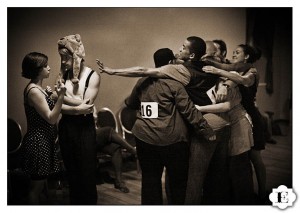 The Ballroom as named by Mura Dehn in her documentary (today referred to as Ballrooming) was a slow dance done by Lindy Hoppers at the Savoy Ballroom to Blues music. It satisfied a Harlem need for a slower, fluid, but highly rhythmic dance with expressive body movements which could not be facilitated by the upright stance of European ballroom dances.
The Ballroom as named by Mura Dehn in her documentary (today referred to as Ballrooming) was a slow dance done by Lindy Hoppers at the Savoy Ballroom to Blues music. It satisfied a Harlem need for a slower, fluid, but highly rhythmic dance with expressive body movements which could not be facilitated by the upright stance of European ballroom dances.
The Fish Tail is a movement in which the buttocks form a variety of figure eights by weaving out, back, and up. Although the Fish Tail came from Africa, it was considered obscene when dancing in the European fashion with one arm around a partner’s waist. The African dance disdains bodily contact.
The Funky Butt, Squat, Fish Tail, and Mooche are all performed with hip movements. Similar dances were popular in New York City by 1913. When dancers at the Jungles Casino-“officially a dancing school” “got tired of two-steps and schottiches…they’d yell: ‘let’s go back home!’…’Let’s do a set’…or ‘Now put us in the alley!’ I did my Mule Walk or ‘Gut Stomp’ for these country dances.”, according to pianist James P. Johnson. “The dancers were from the Deep South.”
Funky Butt – “Well, you know the women sometimes pulled up their dresses to show their pretty petticoats-fine linen with crocheted edges-and that’s what happened in the Funky Butt…. When (Big)Sue arrived at my father’s tonk, people would yell…”Do the Funky Butt, Baby!” As soon as she got high and happy, that’s what she’d do, pulling up her skirts and grinding her rear end like an alligator crawling up a bank.”
The Slow Drag in its various forms was first documented during, and danced to the music of, the ragtime era.
Snake Hips is a movement in which the knees are moved forward and back, first one knee then the other, while keeping the feet together. As in Ball the Jack, in which the knees are held together, this results in a rotation of the hips.
The Strut is similar to, or even “virtually indistinguishable” from dances seen in South Africa, Ghana, and Nigeria. Strutting was often associated with cakewalking. “You had a lot of strut in the Cakewalk-lots of fellows walked like that just for notoriety-and they could really show off.” “George “Bon Bon” Walker was the greatest of the strutters, and the way he promenaded and pranced was something to see,” and was “the man who turned the Strut into the Cakewalk.”
Blues dances as a genre have been said to share a certain aesthetic:
- An athletic and grounded body posture and movement, characterized by the weight being held on the balls of the feet, the knees bent, the hips pushed back, and the chest forward.
- An asymmetry and polyphonic look/feel to the body, characterized by an equality of body parts. No limb or part has precedence, but they all work together both in a simultaneous and serialized fashion. The focus and weight shifting moves through various parts of the body; poly-centric.
- Rhythmic movement. Not just a single rhythm being used in/with the body, multiple meters or rhythms are used. Articulated movement in the torso (chest, rib cage, pelvis, butt) identifying and emphasizing different rhythms.
- Improvisation between dancers and on their own movements. Based on the rhythm section of the band.
- A drawing of the beats, dancing in the space between the beats, pushing and pulling creating a sense of tension both in the body and the body moving through space, while remaining loose and relaxed.

